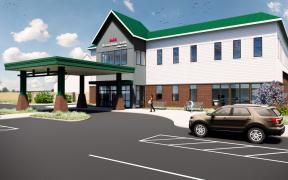What is diffuse lung disease?
Diffuse lung disease (also known as interstitial lung disease) causes scarring in the deep tissue of both lungs that gets worse over time. With scarring, not as much oxygen can get from the lungs into the blood to be delivered to the body. There is no cure for diffuse lung disease but symptoms can be managed. Diffuse lung disease can be caused from breathing in hazardous materials, such as asbestos, silica dust or coal dust. Other causes for diffuse lung disease include:
- Rheumatoid arthritis, lupus or other autoimmune diseases
- Breathing in certain molds
- Certain medications
- Radiation therapy to the chest
- Smoking
The main symptom is feeling short of breath. This might make you feel like you need to breathe faster or that you need to take deeper breaths to get the air you need. Shortness of breath can get worse over time and show up during activities like bathing, talking or dressing. Other symptoms include:
- A dry cough
- Weight loss
- Extreme tiredness
- Muscle or joint pain
If you have more advanced diffuse lung disease you might notice:
- Blue lips, skin or fingernails
- Enlargement of the base of your fingernails
- Arthritis
A physical exam is done to help diagnose diffuse lung disease. A dry, crackling sound that can be heard through a stethoscope is a common sign. Other tests may include:
-
Blood test
-
Chest x-ray
-
CT scan
-
Echocardiogram
-
Lung biopsy
-
Check of blood oxygen levels
There are different treatment options depending on the cause of diffuse disease. For example, if your disease is caused by an autoimmune problem, your doctor will want to give you medicine to suppress your immune system. For the most part, treatment will focus on helping you breathe better and feel comfortable. This includes:
-
Oxygen therapy
-
Medication, including steroids
-
Lung rehabilitation (physical therapy and exercise)
-
Nutrition counseling
-
Sometimes patients with interstitial lung disease may undergo evaluation for lung transplant
Your primary care provider may recommend that you see a pulmonologist for further evaluations and treatment.
Ready to quit tobacco?
Whether you smoke, vape or use smokeless products like pouches – quitting tobacco is one of the best things you can do for your health.
For free coaching and resources, call 1-800-QUIT-NOW or visit MaineQuitLink.com.
































